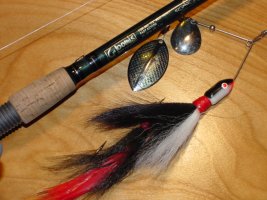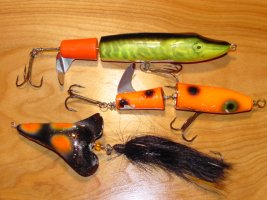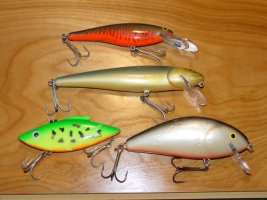|
Throughout the
course of an average summer, I field a lot of questions about
Musky fishing. Some come from customers, others from web site
visitors and the rest from folks I meet along the fishing trail.
Most of the time we talk about where they’re bitin’, what they’re
bitin’ on and so on. Now if I lived in Wisconsin or maybe up on
Lake of the Woods, a lot of these conversations would translate
into Musky fishing trips, but not here in Minnesota. Lots of times
the chat about Muskies is just that, passing conversation.
I don’t know why exactly, but here in Minnesota there are
still a lot of folks who are curious about Muskies and Musky
fishing, but manage to avoid actually trying it. Somehow they’ve
been convinced that there’s a lot more to it than there really is.
Granted, there are a few basic tricks to learn and you do need to
buy at least a few pieces of special gear to get started. But if
you want to, you can unlock the mystery and become a better Musky
angler a lot faster than you think. So for the curious but
uninitiated, lets have a quick peak at what it really takes to get
started.
First off, let me say that the big trick (if there is one) is
to spend some time on “good Musky Water”. You’ll learn more and
develop confidence a lot faster if you spend your time fishing
lakes with good populations of fish. Avoid the old trap of heading
out to every lake that is rumored to have a couple of big ones,
you can do better than that. Thanks in large part to the efforts
of Musky devotees and organizations like Muskies, Inc. with
cooperation from the DNR, there are more Muskies to catch today
than ever before. Take advantage of the wealth of information that
these folks have put together and in short order you’ll have a
good list of quality lakes to get started on.
I’m trying to keep this simple and take it step by step, so
I’m breaking this down into sections but even before you buy your
first plug or plan your first trip, you can make one decision on
your own. That is to decide which you like better? Trolling or
casting? Not only for Muskies but in general. Most folks have
fishing preferences sort of “built in”.
You see, one key factor in being a successful Musky fisherman
is to like what you’re doing enough to stick with it through the
low action times. In other words, you’ll stay more interested if
you start with a style that you already know you enjoy. Your
battle is half won already if you just stay on the water long
enough to catch your first fish. So, if you really love to troll
but don’t care for casting (or vice versa), go with a system
(style) that most closely matches the way you fish for other
species. The two approaches have their differences and might
require different rods, baits and location. So avoid starting down
a path that’s going to make the journey more difficult by trying
to learn both approaches at the same time.
For part one, I could have chosen either basic trolling or
basic casting presentations. It’s a tough choice because each has
its own merits and each is productive in its own way. So in the
interest of being objective and scientific, I flipped a coin and
casting won.
Part One: Casting for Muskies
My first bit of advice here is to choose three or four of the
simplest presentations and stick with these “no-brainer”
presentations at least during your first several trips. No matter
how tempting it is to branch out too early, doing so will only
complicate your experience by mixing too many variables. Believe
me, you will have plenty of time to fill up your new Musky Tackle
Box, but for now, you’ll want to spend the lions share of your
time learning about Muskies, where they live, what they eat and so
on. You can’t do that when you’re bent over the tackle box
changing baits all day long!
Casting for Muskies is an approach best suited for fishing
shallow water cover. In fact, you can even find good areas to
catch Muskies from shore. Water depths of 20 feet or less and
structure like weed beds, rock piles, shoreline drop off areas and
weed choked bays. You’ll need one versatile casting rod that can
“multi-task”, and a small assortment of baits that will help you
fish the variety of cover types in your lake. When you read my
list of no brainer baits, be sure to take into account the
structure on your lake. If you know you’ll be fishing lots of
heavy weeds, go long on the surface type baits. Lots of deep weeds
and sunken islands? Go long on sub-surface baits. Tailor your
selection to fit your own needs and don’t assume that you need
everything on the list, at least not yet. After you get some
experience Musky fishing, you’ll soon learn which baits to “get
long on” and which to avoid.
To make the “no brainer list” a bait has to be fishable for
everyone no matter how much experience they have (or don’t have),
in other words the bait has to have it’s own built in action.
There are some really fantastic Musky baits that aren’t on this
list and down the line, you should learn to use all of them. But
for now, they’re excluded either because they pose some difficulty
to a less experienced Musky angler or using them correctly calls
for a higher level of experience.
No Brainer #1 Top Water Baits. These baits are the
ultimate for new Musky anglers. They are among the simplest of all
baits to use and they perform exceptionally well over heavy weed
cover but are also fantastic for fishing large shallow sand flats
and adjacent breaklines where long casts are a must. Their
glub-glub-glub sound helps call in fish from a distance and if you
keep throwing, sooner or later you will experience one of those
explosive surface hits that hook you for life. Baits like Salmo’s
Turbo Jack, Arbogast’s Extra Large Jitterbug and Holcombe’s Top
Walkers are among the many great surface plugs. Using these baits
is as simple as casting and reeling, a steady retrieve over heavy
weeds is best. Take care, don’t set the hook until you feel the
fish. Many anglers, even experienced pros get anxious when they
see the boil and set too soon. Remember that when you fish
top-water, you almost always see the fish before it has taken the
bait.
No Brainer #2 Tandem Bucktail Spinnerbaits. I had to
scratch my head about this one, but for my money, I’m going with
the large spinnerbait style bucktails. These are the safety pin
style baits that remind you of the Bass fishing lures you’ve used
or seen used except they’re bigger. They perform more consistently
and are less prone to “quirks” than the in-line type bucktails.
Unlike their inline cousins, it’s far less likely that the blades
will hang up or snag, so you’ll be doing more fishing per cast.
Since these baits that usually have a single hook or two single
hooks instead of treble hooks, they are a lot more weedless and
therefore more versatile. You won’t go five feet in a good Musky
tackle shop without seeing some and they all do pretty much the
same thing, but they’re not all equal. What you’re looking for is
rugged construction, strong hooks and good swivels. Inhaler’s
Rattle Tail Spinnerbait, Northland Tackle’s Bionic Bucktail or the
Lindy-M&G Spinnerbaits are good examples.
No Brainer #3 Crankbaits are another great option for
less experienced Musky anglers because they can be fished in so
many ways. The best thing about most crankbaits is that even if
you don’t know exactly what you’re doing, simply casting them out
and reeling (cranking) them back to the boat can still get you
bit! Shallow running crankbaits can be fished like jerk baits over
weed tops, around rocks or you can use a straight retrieve
parallel to the weedline. Since most of them float, the shallow
running versions provide a bit of immunity from sinking too deep
into weeds and hanging up. As you become experienced, you’ll
discover lots of tricks that add extra dimension to the baits.
Virtually any large, shallow running minnow bait can be used but
my hands down favorite for versatility has become Salmo’s
Whitefish. These baits cast like a rocket and can be fished
shallow with a slow retrieve, deeper with a fast retrieve or they
can be fished like a jerk-bait. Bagley’s DB06, the Floating
Rat-L-Trap and other large minnow type baits are all good choices.
Now that you have a modest selection of reliable baits, you’ll
need a rod/reel combination that works with all of them.
No Brainer #4 G. Loomis Frog Rod. This rod wasn’t
originally designed to be a Musky rod; in fact you have to look in
their Bass section to find it. I don’t care what you hear from
anyone about rods, you won’t find a more versatile, tougher piece
of equipment. I add one or two to my arsenal every season and
these rods are now performing 95 percent of all the big bait
chores in my boat. Over the years a lot of our opinions about rods
have changed. Most of us started out with fairly short “pool cue”
type rods. Today, technology and materials have improved so much
that we can actually use rods that are fun to fish with and still
have power to land a really big one. If you want one rod that you
can do almost everything with, this is it!
Matching it up with a good reel is important and here your
personal preferences and budget are most important. You can find
good quality reels that match up well with these rods from several
manufacturers. Look at Shimano, Garcia and Daiwa. I match the
reels with Fireline because I like the low visibility and low
stretch.
All right, so there’s a start. One good rod, a modest
selection of baits and a couple of ideas to get you started,
that’s as far as we go here. In part two we’ll look at some sure
fire ideas for trolling and go a bit further into Musky location
and feeding preferences.
If you’ve been on the fence about Musky fishing, this year go
ahead and take the plunge! It’s easier than you think, really. |

So you want to get started Musky
fishing but don't have a clue where to start. This super
multi-purpose rig will get you in the ballpark every time. G.
Loomis Frog Rod, 30 pound test and a well built Musky size
Bucktail spinnerbait. Throw it out and reel it in, simple but
effective.

My favorite "no-brainer" top water
baits are guaranteed to stir up some action, these top water baits
combine visibility, sound and simplicity. Salmo's Turbo Jack (top)
plus other chugging top water baits are super simple to use and
cast like rockets.

Bagley DB06, Salmo Whitefish, Floating
Giant Rat-L-Trap and Salmo Fatso are versatile and simple to
operate. Simply retrieving the bait will work because they have
their own built in action, but as you progress, you'll be able to
apply a variety of neat tricks that really help "seal the deal".
_reduced.jpg)
What more proof do you need? Here's a
nice fish for a first effort. Not a giant, but plenty good to get
this new-comer hooked for life.
 |
